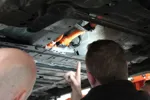Looking at the headline numbers in the latest Trend Tracker, I was immediately struck by what the report calls “not yet serviced”. These are cars that owners have not had serviced since they bought them. For cars less than four years old, the research shows that one-third had not been serviced since purchase. The corresponding figure from the first Trend Tracker in 1994 was 14 per cent.
Between 1994 and 2003, the “not yet serviced” percentage has increased every year for cars less than four years old, and increased quite sharply in the last few years. The explanation is longer service intervals. And it is hardly surprising that this trend has accelerated recently as cars with longer service intervals become older and make up an ever-greater proportion of the car parc. Take, for example, Peugeot. It introduced 20,000-mile or two-year servicing for petrol cars in August 1998, and 10,000 miles or two years for diesels. So every Peugeot car less than four years old is now on long service intervals. In five years time, virtually all Peugeots on the road will have these long service intervals.
But there is a silver lining. Longer service intervals have lowered costs for car owners when they do have to pay for a service. This must have been a major factor in the demise of DIY recorded by Trend Tracker, and apparently benefited independent garages most of all.
Franchised dealers are the sector most at risk from longer service intervals, but the unprecedented level of new car sales in recent years has cushioned the impact. And, as Trend Tracker points out, the owners of cars under four years old, which are “not yet serviced”, are most likely to use their franchised dealer –confirmed by their improved servicing retention of older cars.
Independent garages and franchised dealers cannot be smug about the improvements in servicing retention. Longer intervals require accurate customer follow-up, if you want the business. And the car sales department must improve communication if customers are visiting the workshop less frequently, or they could miss the next sale.













Login to comment
Comments
No comments have been made yet.